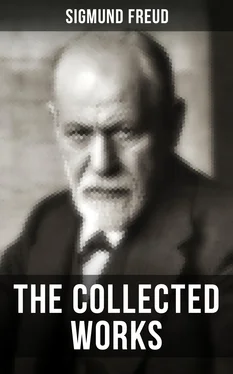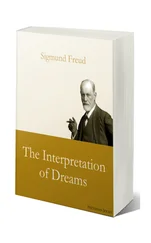A noteworthy connection between the symptoms of the true neuroses and the psychoneuroses adds a valuable contribution to our knowledge of symptom formation in the latter. The symptom in the true neuroses is frequently the nucleus and incipient stage of development of the psychoneurotic symptom. Such a connection is most easily observed between neurasthenia and the transference neuroses, which are termed conversion hysteria, between anxiety neurosis and anxiety hysteria, but also between hypochondria and paraphrenia (dementia praecox and paranoia), forms of neuroses of which we shall speak subsequently. Let us take as an illustration the hysteric headache or backache. Analysis shows that through elaboration and displacement this pain has become the gratification substitute for a whole series of libidinous phantasies or reminiscences. But once upon a time this pain was real, a direct sexual toxic symptom, the physical expression of libidinous excitation. We do not wish to assert, by any means, that all hysteric symptoms can be traced to such a nucleus, but it is true that this is frequently the case, and that all influences upon the body through libidinous excitation, whether normal or pathological, are especially significant for the symptom development in hysteria. They play the part of the grain of sand which the mollusc has enveloped in mother-of-pearl. In the same way passing signs of sexual excitation, which accompany the sexual act, are used by psychoneurosis as the most convenient and appropriate material for symptom formation.
A similar procedure is of diagnostic and therapeutic interest especially. Persons who are disposed to be neurotic, without suffering from a flourishing neurosis, frequently set in motion the work of symptom development as the result of an abnormal physical change — often an inflammation or an injury. This development rapidly makes the symptom given by reality the representative of the unconscious phantasies that had been lurking for an opportunity to seize upon a means of expression. In such a case the physician will try different ways of therapy. Either he will try to do away with the organic basis without bothering about its noisy neurotic elaboration, or he will struggle with the neurosis brought out by the occasion, and ignore its organic cause. The result will justify now one, now the other method of procedure; no general laws can be laid down for such mixed cases.
TWENTY-FIFTH LECTURE
GENERAL THEORY OF THE NEUROSES
FEAR AND ANXIETY
Table of Contents
Probably you will term what I told you about ordinary nervousness in my last lecture most fragmentary and unsatisfactory information. I know this, and I think you were probably most surprised that I did not mention fear, which most nervous people complain of and describe as their greatest source of suffering. It can attain a terrible intensity which may result in the wildest enterprises. But I do not wish to fall short of your expectations in this matter. I intend, on the contrary, to treat the problem of the fear of nervous people with great accuracy and to discuss it with you at some length.
Fear itself needs no introduction; everyone has at some time or other known this sensation or, more precisely, this effect. It seems to me that we never seriously inquired why the nervous suffered so much more and so much more intensely under this condition. Perhaps it was thought a matter of course; it is usual to confuse the words “nervous” and “anxious” as though they meant the same thing. That is unjustifiable; there are anxious people who are not nervous, and nervous people who suffer from many symptoms, but not from the tendency to anxiety.
However that may be, it is certain that the problem of fear is the meeting point of many important questions, an enigma whose complete solution would cast a flood of light upon psychic life. I do not claim that I can furnish you with this complete solution, but you will certainly expect psychoanalysis to deal with this theme in a manner different from that of the schools of medicine. These schools seem to be interested primarily in the anatomical cause of the condition of fear. They say the medulla oblongata is irritated, and the patient learns that he is suffering from neurosis of the nervus vague. The medulla oblongata is a very serious and beautiful object. I remember exactly how much time and trouble I devoted to the study of it, years ago. But today I must say that I know of nothing more indifferent to me for the psychological comprehension of fear, than knowledge of the nerve passage through which these sensations must pass.
One can talk about fear for a long time without even touching upon nervousness. You will understand me without more ado, when I term this fear real fear in contrast to neurotic fear. Real fear seems quite rational and comprehensible to us. We may testify that it is a reaction to the perception of external danger, viz., harm that is expected and foreseen. It is related to the flight reflex and may be regarded as an expression of the instinct of self-preservation. And so the occasions, viz., the objects and situations which arouse fear, will depend largely on our knowledge of and our feeling of power over the outer world. We deem it quite a matter of course that the savage fears a cannon or an eclipse of the sun, while the white man, who can handle the instrument and prophesy the phenomenon, does not fear these things. At other times superior knowledge promulgates fear, because it recognizes the danger earlier. The savage, for instance, will recoil before a footprint in the woods, meaningless to the uninstructed, which reveals to him the proximity of an animal of prey; the experienced sailor will notice a little cloud, which tells him of a coming hurricane, with terror, while to the passenger it seems insignificant.
After further consideration, we must say to ourselves that the verdict on real fear, whether it be rational or purposeful, must be thoroughly revised. For the only purposeful behavior in the face of imminent danger would be the cool appraisal of one’s own strength in comparison with the extent of the threatening danger, and then decide which would presage a happier ending: flight, defense, or possibly even attack. Under such a proceeding fear has absolutely no place; everything that happens would be consummated just as well and better without the development of fear. You know that if fear is too strong, it proves absolutely useless and paralyzes every action, even flight. Generally the reaction against danger consists in a mixture of fear and resistance. The frightened animal is afraid and flees. But the purposeful factor in such a case is not fear but flight.
We are therefore tempted to claim that the development of fear is never purposeful. Perhaps closer examination will give us greater insight into the fear situation. The first factor is the expectancy of danger which expresses itself in heightened sensory attention and in motor tension. This expectancy is undoubtedly advantageous; its absence may be responsible for serious consequences. On the one hand, it gives rise to motor activity, primarily to flight, and on a higher plane to active defense; on the other hand, it gives rise to something which we consider the condition of fear. In so far as the development is still incipient, and is restricted to a mere signal, the more undisturbed the conversion of the readiness to be afraid into action the more purposeful the entire proceeding. The readiness to be afraid seems to be the purposeful aspect; evolution of fear itself, the element that defeats its own object.
I avoid entering upon a discussion as to whether our language means the same or distinct things by the words anxiety, fear or fright. I think that anxiety is used in connection with a condition regardless of any objective, while fear is essentially directed toward an object. Fright, on the other hand, seems really to possess a special meaning, which emphasizes the effects of a danger which is precipitated without any expectance or readiness of fear. Thus we might say that anxiety protects man from fright.
Читать дальше












